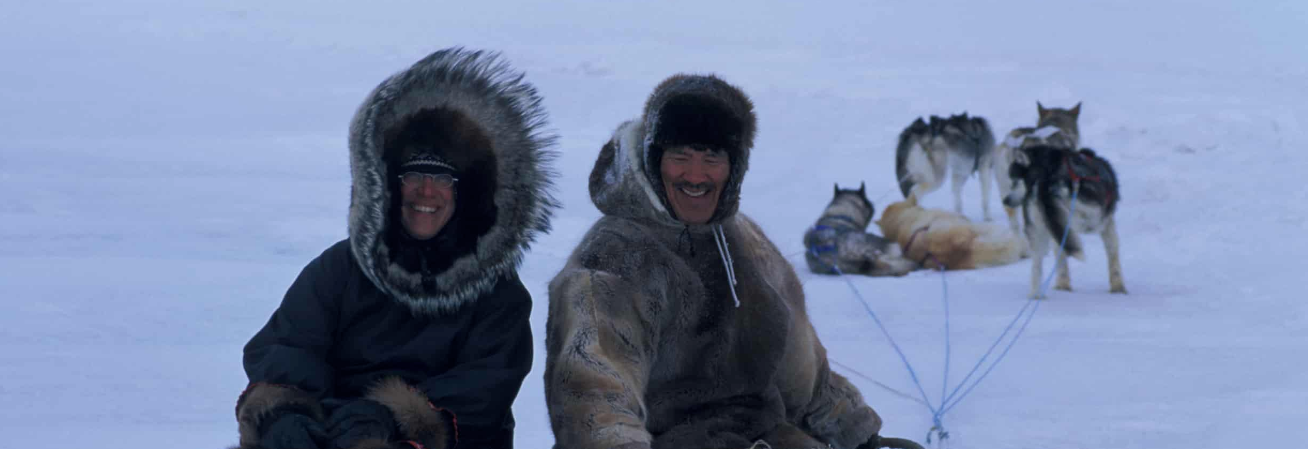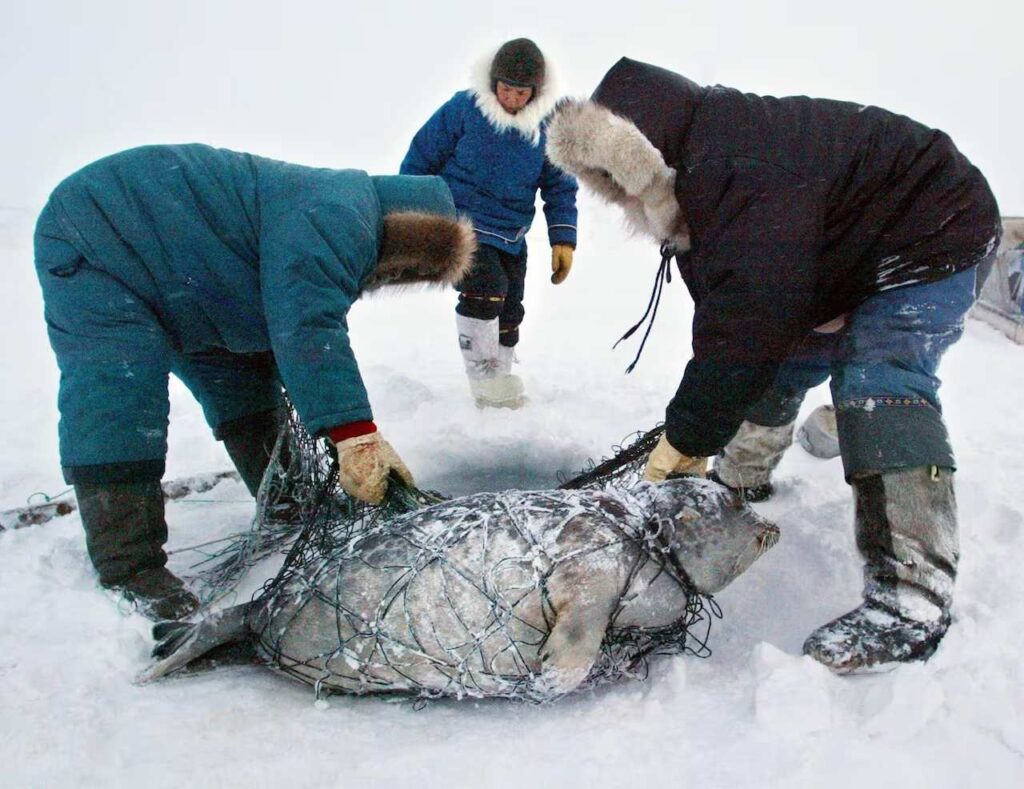Inuit Sealing Traditions: Vital Part of Culture, Economy, and Sustainability

Inuit seal hunting is integral to Inuit traditions and livelihood in Nunavut, with a history spanning thousands of years. This traditional practice not only provides essential resources for Inuit communities but also holds deep cultural and spiritual significance. In this article, we will explore the importance of sealing to Inuit customs, its role in the modern Nunavut economy, and the sustainable and humane practices that guide this vital tradition.
History and Cultural Significance
Inuit hunters have relied on seal hunting for countless generations, developing a profound understanding of the Arctic environment and a strong connection to the animals they hunt. Inuit hunting traditions are not merely a means of subsistence; they are a fundamental part of Inuit identity and spirituality.
Through sealing, the Inuit have accumulated a vast body of traditional ecological knowledge, which emphasizes sustainability, respect for the environment, and the responsible use of resources. Inuit ceremonies and celebrations often incorporate elements of seal hunting, highlighting its central role in Inuit culture.
Do You Know? Seal Hunting Facts
- Inuit hunters primarily target ringed seals, which are the most abundant seal species in the Arctic.
- Seal meat is an excellent source of protein, iron, and omega-3 fatty acids, making it a nutritious staple in the Inuit diet.
- Inuit hunters use a variety of traditional methods to hunt seals, including harpooning from the edge of sea ice and using dogs to locate breathing holes.
- Seal oil, derived from blubber, is used as a traditional fuel source for lamps and as a valuable source of nutrients.
- Sealskin is not only used for clothing but also for making traditional boats called kayaks and umiaqs.
- Inuit hunters have a deep respect for seals and believe in using every part of the animal, minimizing waste and honoring the spirit of the seal.
Sealing in Modern Nunavut
In contemporary Nunavut, sealing continues to play a crucial role in the local economy and the traditional Inuit economy. Many Inuit communities rely on seal hunting as a primary source of income, with the sale of seal products contributing significantly to household budgets.
However, Inuit hunters face numerous challenges, including changing environmental conditions, high costs of hunting equipment, and fluctuating market demands. The cost of living in Iqaluit and other cities in Nunavut is notably high, making the economic benefits of sealing all the more important for Inuit communities.
Seal Products and Their Uses
| Species | Primary Use | Secondary Uses | Cultural Significance |
| Ringed Seal | Food (meat) | Clothing, tools, oil | Central to survival and traditional diet |
| Harp Seal | Clothing (pelts) | Food, oil | Used in ceremonies and crafts |
| Bearded Seal | Tools (from bones and teeth) | Food, clothing | Symbol of strength and skill in hunting |
| Hooded Seal | Clothing (especially for harsh conditions) | Food, oil | Valued for its large size and thick pelt |
Table 1: Seal Species and Their Uses in Inuit Culture (Source: Arctic Wildlife Studies)
Food and Nutrition
Seal meat is a highly nutritious and culturally important food source for Inuit. Rich in protein, iron, and omega-3 fatty acids, seal meat helps to maintain the health and well-being of Inuit communities in a harsh Arctic environment where access to affordable, nutritious store-bought food is limited.
Clothing and Fashion
Seal pelts have been used for centuries to create warm, durable, and waterproof clothing essential for survival in the Arctic. Inuit traditional clothing made from seal pelts includes parkas, mittens, boots, and hats.
In recent years, Nunavut designers have been incorporating seal pelts into contemporary fashion, creating unique and stylish garments that celebrate Inuit culture and promote the sustainable use of seal products. These designs help to raise awareness about Inuit sealing traditions and contribute to the local economy.
Other Uses
In addition to food and clothing, seal products are used to create a variety of tools, crafts, and artwork. These items not only serve practical purposes but also showcase the creativity and skill of Inuit artisans.

Sustainability and Humane: Key Principles of Inuit Sealing
Inuit seal hunting is guided by three key principles: sustainable harvest, complete use, and humane methods. Inuit hunters strive to maintain a balance between the needs of their communities and the long-term health of seal populations. They ensure that no part of the seal is wasted, utilizing every component for food, clothing, or other purposes. Moreover, the Inuit employ humane hunting methods that prioritize the swift and efficient dispatch of seals to minimize suffering.
Inuit Traditional Knowledge and Wildlife Management
Inuit traditional knowledge plays a vital role in the sustainable management of seal populations. This knowledge, passed down through generations, encompasses a deep understanding of seal biology, behaviour, and habitat. Inuit hunters work closely with wildlife managers and researchers to incorporate traditional knowledge into modern conservation efforts, ensuring the sustainability of seal hunting practices.
Cooperation with Scientific Research and Conservation Efforts
Inuit communities actively participate in scientific research and conservation initiatives related to seals and other Nunavut animals. This collaboration helps to ensure that management decisions are informed by both traditional knowledge and scientific data, promoting the long-term sustainability of seal populations.
Regulations and Trade Challenges
The Canadian government regulates the seal hunt through the Marine Mammal Regulations under the Fisheries Act. These regulations set quotas, establish humane hunting methods, and enforce other management measures to ensure the sustainability of seal populations.
Nunavut has a significant role in the management of sealing through the Nunavut Wildlife Management Board (NWMB), which is responsible for making decisions related to wildlife conservation and harvesting. The NWMB works in collaboration with Inuit communities, the federal government, and other stakeholders to develop and implement sealing regulations and policies.
Challenges to Trade
| Product Type | Local Use (%) | Exported (%) | Key Markets for Exports |
| Seal Meat | 80 | 20 | Indigenous communities, local markets |
| Seal Pelts | 50 | 50 | EU (under Indigenous exemption), Asia |
| Seal Oil | 70 | 30 | Health supplements, local and international markets |
Table 2: Economic Impact of Seal Products (Source: Nunavut Seal Products Marketing Board)
Animal rights organizations have long criticized the commercial seal hunt, often conflating it with Inuit subsistence sealing. These campaigns have led to widespread misconceptions about Inuit sealing practices and have negatively impacted the market for seal products, including the Inuit fur trade.
In 2009, the European Union (EU) implemented a ban on the import and sale of seal products, with an exemption for products derived from hunts conducted by Indigenous communities for subsistence purposes. While this exemption aimed to protect Inuit sealing, it has faced challenges in implementation and has not fully mitigated the economic impact of the ban on Inuit communities.
Inuit organizations and the Canadian government have been working to address market access issues for seal products. Initiatives such as the Certification and Market Access Program for Seals (CMAPS) aim to support Inuit sealers by developing certification systems, promoting market access, and providing business development assistance.
Countering Misconceptions and Stereotypes
Inuit sealing has often been misrepresented in media and animal rights activism, leading to widespread misconceptions about the nature and purpose of this traditional practice. These misrepresentations have perpetuated harmful stereotypes and undermined Inuit efforts to maintain their cultural heritage and economic well-being.
To address these misconceptions, it is essential to engage in respectful dialogue that centers on Inuit perspectives and experiences. Inuit voices must be at the forefront of discussions about sealing, ensuring that their traditional knowledge, cultural values, and socio-economic realities are fully understood and respected.
The debate surrounding Inuit sealing often involves complex issues related to animal welfare, sustainability, and Indigenous rights. It is crucial to approach these issues with nuance and sensitivity, recognizing that Inuit have a deep understanding of the Arctic environment and a strong commitment to the responsible use of resources.
Preserving and Promoting Inuit Sealing Traditions
Inuit-led Initiatives to Support Sealing
Inuit organizations and communities have been at the forefront of efforts to preserve and promote their sealing traditions. These initiatives include public education campaigns, cultural events, and economic development projects that showcase the importance of sealing to Inuit identity and livelihoods.
Government Programs and Policies
The Canadian government has implemented various programs and policies to support Inuit sealing, such as the Certification and Market Access Program for Seals (CMAPS). These initiatives aim to create a sustainable and economically viable sealing industry that benefits Inuit communities while ensuring the humane treatment of seals.
Education and Public Awareness
Education and public awareness are critical components of preserving and promoting Inuit sealing traditions. By sharing their knowledge, experiences, and perspectives with a broader audience, Inuit communities can foster a greater understanding and appreciation of their cultural heritage and the importance of sealing to their way of life.
Encouraging pride in Inuit sealing heritage is essential for the long-term sustainability of this traditional practice. By celebrating the skills, knowledge, and values associated with sealing, Inuit communities can inspire younger generations to embrace their cultural identity and continue the responsible stewardship of the Arctic environment.
Sealing in Inuit Culture
Inuit sealing traditions in Nunavut are a vital part of the region’s culture, economy, and sustainability. By understanding the deep historical and cultural significance of sealing, the diverse uses of seal products, and the sustainable and humane practices employed by Inuit hunters, we can better appreciate the importance of this traditional practice. Addressing the challenges faced by Inuit sealers, countering misconceptions, and promoting respectful dialogue are essential steps in preserving and promoting Inuit sealing traditions for generations to come.

More Resources:
Seals and sealing: https://www.dfo-mpo.gc.ca/fisheries-peches/seals-phoques/index-eng.html
Fisheries and Sealing Division Strategic Plan (2023-2028): https://assembly.nu.ca/sites/default/files/2023-11/FSD%20Strategic%20Plan%2008-30-2023-clean.pdf
